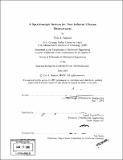A spectroscopic system for near infrared glucose measurement
Author(s)
Saptari, Vidi Alfandi, 1975-
DownloadFull printable version (8.471Mb)
Other Contributors
Massachusetts Institute of Technology. Dept. of Mechanical Engineering.
Advisor
Kamal Youcef-Toumi.
Terms of use
Metadata
Show full item recordAbstract
Noninvasive blood glucose monitoring has been long envisioned to serve as an invaluable tool in the treatment of diabetes. The current invasive method makes it difficult for diabetic patients to perform frequent blood glucose measurements and maintain better control of their glucose levels, crucial in reducing the risks of complications. In this thesis, the use of the near infrared absorption spectroscopy is proposed and investigated. The light radiation is envisioned to be transmitted through thin tissue such as the webbing tissue between the thumb and the index finger. The main technical difficulties are identified to be those caused by complex interferences from other physiological variables and the weak near infrared glucose signals. Thus, the success of such a method hinges on adequately isolating the glucose signals from among the interferences as well as on obtaining high signal-to-noise-ratio spectra. The first objective of this thesis is to provide deeper quantitative understanding to the challenges described above. Such knowledge is key to developing clinically accurate and robust devices. This objective is accomplished through a series of systematic experimental and analytical investigations involving glucose measurements in various biological sample matrices. (cont.) Analytical figures of merit such as "selectivity" and "limit of detection" are defined, and used to quantify the signal quality and to predict the robustness of the method. The second objective of this thesis is to design an optimum spectroscopic system for the near infrared glucose measurements in the methodically selected band region approximately between 2100 and 2300 nm. A unique, filter spectrometer is developed, which enables spectral signal-to-noise ratio improvement by an order of magnitude over the published data to-date employing top-grade commercial spectrometers, while significantly reducing the required signal acquisition time and hardware complexity. A spectral processing algorithm is developed, which enables the effective removal of spectral variations caused by changes or drifts in the instrument, environment and/or sample conditions, as well as those due to tissue scattering. The spectroscopic system is tested in experiments measuring glucose in synthetic biological solutions, human plasma samples and animal tissue samples. The thesis demonstrates that with a carefully designed system, noninvasive blood glucose measurements using the near infrared absorption spectroscopy is feasible.
Description
Thesis (Ph. D.)--Massachusetts Institute of Technology, Dept. of Mechanical Engineering, 2004. Includes bibliographical references.
Date issued
2004Department
Massachusetts Institute of Technology. Department of Mechanical EngineeringPublisher
Massachusetts Institute of Technology
Keywords
Mechanical Engineering.